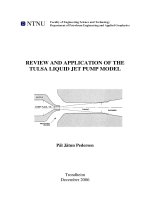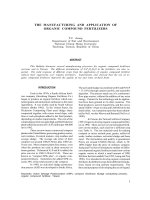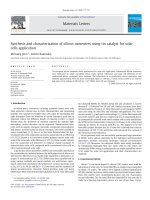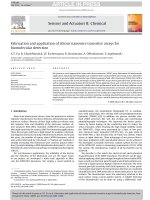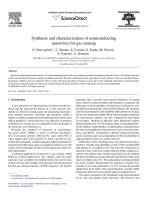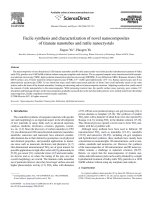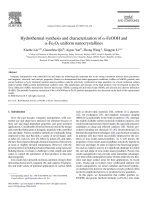Synthesis and Application of Nanosize Semiconductors for Photoxidation of Toxic Organic Chemicals pptx
Bạn đang xem bản rút gọn của tài liệu. Xem và tải ngay bản đầy đủ của tài liệu tại đây (424.69 KB, 22 trang )
tsnl
Synthesis and Application of Nanosize Semiconductors
for Photoxidation of Toxic Organic Chemicals
J.P. Wilcoxon,
Nanostructures and Advanced Materials Chemistry
Sandia National Laboratories
Albuquerque, N.M., 87185-1421
Colloborators: T.R. Thurston, P. Provencio, G.A. Samara
Talk Outline
•Industrial Solvents in the Environment (Impregnated Sediments, Water Table)
•Brief History of the problem and possible remediation approaches
(Bioremediation, Soil Washing, Adsorption, Photooxidation)
•Photocatalysis using UV light and nanosize TiO
2
and SnO
2
.
•Photocatalysis using visible light and MoS
2
nanoclusters.
Acknowledgement: Div. Of Materials Science and Engineering, Office of Science, US Dept. of
Energy under contract DE-AC-04-AL8500. Sandia is a multiprogram laboratory operated by Sandia
Corporation, a Lockheed-Martin Company, for the US Dept. of Energy. This work performed under
the aupices of the DOE Environmental Science/Environmental Research (ER/ES) Program.
tsnl
Typical Scenario-Dense Non-Aqueous Solvent Pools
Rain
Organic Pool in Soil
Slow Leaching
Water Table
Examples-
Cleaning Solvents- Tri-Chloroethylene (TCE)
Herbicides/Fungacides/Pesticides (Pentachlorophenol (PCP), DDT)
Explosives (e.g. TNT)
Major Remediation Issues-
1) Low Solubility (1-10 ppm) in water provides continuous leaching with time
2) Treatment of large volumes of highly diluted toxins
3) Cost of treatment
tsnl
Possible Treatment Approaches-
Step 1: Excavation, Soil Washing
Conventional Treatment Options:
1)Filtration and/or Adsorption of toxic chemicals in aqueous supernatant from Step 1
2)Chemical Oxidation or Total Mineralization of the the Organics
3)Deep UV Photooxidation of the Organics
4)Photocatalytic oxidation of the Organics (e.g. colloidal titania slurries)
Cost and large volumes involved are the principal practical concerns.
tsnl
Alternative Approach
Use stable, inorganic, semiconductor nanoclusters with tunable bandgaps to
oxidize organic chemicals using sunlight
MoS
2
nanocrystal
+ + + +
electron/hole
transfer reactions
CO
2
+HCl
sunlight
chlorinated
aromatic
+ H
2
O
e
h
+
Clusters can be used in both dispersed and heterogeneous forms (supported)
tsnl
Advantanges of this Approach-
•The light absorption and energy levels of the semiconductor valence and conduction
bands can be adjusted in a single material by changing the size (quantum
confinement effect).
•A covalent semiconductor material with excellent photostability and low toxicity can
be selected (e.g. MoS
2
).
•Our synthesis allows easy chemical modification of the nanocluster surface
properties (e.g. deposition of a metal).
•Small size of nanocluster vastly reduces electron-hole recombination rate and
undesired light scattering.
•Nanoclusters are easily deposited on bulk support materials from a dispersed liquid
phase.
•Both dispersed and supported nanoclusters can be studied, allowing complete
characterization of the photocatalyst microstructure.
tsnl
Photocatalysts Material Requirements -
1) Efficient conversion of sunlight to electron-hole pairs.
2) Surface trapping of electrons and holes before recombination.
3) Catalyst photostability.
4) Inexpensive, chemically-stable, environmentally benign materials.
tsnl
MoS
2
layered structure gives chemical stability-
Mo, W
S, Se
12.3 Å
weak van-der-Waals forces
:N
:N
bipyridine
(bpy)
Binding of substrate organic chemical occurs at metal edge sites.
Electron transfer rates allow an estimation of shift of the redox potential with size
tsnl
MoS
2
, Like TiO
2
Has Exceptional Photostability-
Energy
Valence
Band
S 3p
MoS
2
Mo, 4 d
z
1.33 V
Conduction
Band
Mo, 4d
xy
0.1 V
+
-
+
-
light
S 3p
CdS
Cd, 5s
+
-
+
-
2.4 V
Covalent Semi-conductors (Stable)
Ionic II-VI Materials
Carrier Excitation Weakens
Chemical Bonds (Unstable)
Kinetic stability occurs because both valence and conduction bands are localized on the metal, so
carrier excitation doesn’t weaken any chemical bonds
tsnl
MoS
2
synthesis, purification, and characterization-
Synthesis in Inverse Micelle System
Mo
4+
+ 2S
2-
= MoS
2
Mo Source: MoCl
4
, S Source: H
2
S, Oil: Octane
Typical Surfactant: Tri-ocytlmethylammonium Chloride (TOAC)
tsnl
Purification by extraction into Acetonitrile (ACN)
MoS2
In Oil
ACN
With hydrophilic cationic Surfactant
With Hydrophobic TOAC Surfactant
Oil
MoS2
In ACN
1) Liquid Chromatography shows the MoS
2
clusters have a net charge.
2) Samples diluted into water are dialized to remove unwanted ions like SO
4
-2
3) Analysis by XRF gives the final [Mo] and [Mo]:[S]~ 1 : 2.4 for D=3 nm.
tsnl
Quantum Size Effects influence the optical and electronic
properties of the resulting solutions-
10
0
10
1
10
2
10
3
10
4
10
5
200 400 600 800 1000
b
ance(a.u.)
Wavelength(nm)
bulk
4.5 nm
3.0 nm
2.5 nm
d < 2.5 nm
By adjusting the size alone, the conductance and valence band energy levels
can be shifted allowing new types of photocatalytic behavior to occur
tsnl
Structural/Size Characterization-
0
20
40
60
80
100
10 20 30 40 50 60
MoS
2
(d=4.5 nm)
MoS
2
powder std
Intensity(a.u.)
two theta (degrees)
<002>
<004>
<100>
<101>
<102>
<103>
<006>
<105>
<110>
<106>
0
20
40
60
80
100
120
140
160
0 5 10 15 20 25
250 nm
350 nm
Absorbance(a.u.)
Elution time(min)
clusters
chemical
byproduct
impurities
Chromatogram of clusters
Linewidth(polydispersity) comparable to
chemical impurities
tsnl
Light Absorbance and Redox Potentials-
-1.0
0.0
1.0
2.0
3.0
Redox Potentials of Various Semiconductors at pH 7
Potental vs. NHE
H
2
O/OH
.
potential
TiO
2
MoS
2
(bulk)
MoS
2
(d=4.5 nm)
MoS
2
(d=8-10 nm)
0.00
200.00
400.00
600.00
800.00
1000.00
200 400 600 800 1000 1200 1400
Spectral Irradiance (W/m
2
/
µ
m)
Wavelength (nm)
TiO
2
,
bulk
2
(d=4.5 nm)
2
(d=8-10 nm)
2
(bulk)
Greater light absorbance reduces the ability to oxidize a given organic.
Mixtures of Nanoclusters will likely optimize the photooxidation process.
tsnl
Photochemical Reactor-
400 W Xe arc lamp with long pass filters.
Cylindrical reactor with sampling port and overhead illumination.
tsnl
Liquid Chromatography is Used to Follow the Kinetics of
Photo-Redox Reactions-
Basic Concept -
• Chemicals (and dispersed nanoclusters)
travel through a porous medium which
separates them and they elute at various
times.
• The amount of chemical in each elution
peak is measured using an absorbance or
fluorescence detector and compared to
known amounts of the same chemical.
• Intermediate break-down products are
also identified.
• The size of the elution peak at a chosen
absorbance wavelength gives the amount
of each chemical.
• The stability of the nanosize photocatalyst
can be determined from changes in the
complete absorbance spectrum at its
elution peak.
Example - Destruction of an Alkyl
Chloride Organic Impurity using
dispersed nanosize (D = 3 nm) MoS
2
.
0
200
400
600
800
1000
345678
Absorbance (250 nm)
elution time (min)
MoS
2
Photocatalyst
t = 0
organic impurity
increasing
time
Organic Impurity
Oxidized to CO
2
tsnl
Optical Absorbance of Nanocluster Catalyst is Unchanged-
0
100
200
300
400
500
600
700
800
200 250 300 350 400 450 500 550 600
MoS
2
Optical Absorption
before photocatalysis
after all organics
are oxidized
Absorbance
Wavelength (nm)
No reduction in optical absorbance, nanocluster concentration, or
photocatalytic activity were observed
tsnl
Photocatalysis of Phenol Using Nanosize MoS
2
Supported on
TiO
2
Powder
• Visible Light Absorbance by MoS
2
.
• Carrier transfer between MoS
2
and TiO
2
slurry particles decreases recombination rate and
increases photooxidation rate of organic.
0
1
2
3
4
5
12345
Phenol Destruction Rate (%/min)
MoS
2
loading (weight %)
15
16
17
18
19
20
21
0 100 200 300 400 500
Phenol Concentration (mg/l)
Time (seconds)
TiO
2
MoS
2
(d=4.5 nm)
MoS
2
(d=8-10 nm)
λ>450 nm illumination
tsnl
Photocatalysis of Phenol Using Nanosize MoS
2
Supported on
TiO
2
Powder
15
16
17
18
19
20
21
0 100 200 300 400 500
Phenol Concentration (mg/l)
Time (seconds)
TiO
2
MoS
2
(d=4.5 nm)
MoS
2
(d=8-10 nm)
λ>450 nm illumination
• Visible (λ>450 nm)Light Absorbance by MoS
2
shows exponential photo-oxidation kinetics.
• A strong size dependence of photo-oxidation rate is observed.
tsnl
Pentachlorophenol (PCP) Photocatalysis Studies-
UV Photooxidaton using D=25 nm,
SnO
2
Clusters
PCP UV Photooxidation Results
using TiO
2
(Degussa)
0
50
100
150
200
250
300
0 5 10 15
t=0
t=15
t=30
t=120
t=240 min
A(215nm)
t(min)
pcp
t=7.62t=5.75
0
50
100
150
200
0 2 4 6 8 10 12 14
t=0 min
t=30
t=120
t=480
A(215nm)
t(min)
pcp
t=5.90
t=3.31
Intermediate Photooxidation Products Depend on Catalyst Material
tsnl
PCP Photooxidation Results(Summary)
Visible Light Photooxidation Results
PCP UV Photooxidation Results
0.01
0.1
1
0 100 200 300 400 500 600 700
Relative PCP concentration
time(min)
No Catalyst
TiO
2
(d=20 nm)
SnO
2
(d=25 nm)
SnO
2
(d=58 nm)
TiO
2
(Degussa)
0.01
0.1
1
0 100 200 300 400 500 600 700 800
No Catalyst or TiO
2
CdS(0.1 mg/ml) powder
MoS2,d=4.5,0.036 mg/ml
MoS2,d=3.0 nm,0.09 mg/ml
Relative PCP concentration
time(min)
CO
2
measured at end of reaction confirms total photooxidation of PCP.
tsnl
Conclusions
Photo-oxidation of an alkyl chloride by nanosize MoS
2
shows a strong size
dependence and occurs with weak visible illumination.
HPLC analysis demonstrates that no changes occur in the quantity or
absorbance properties of nanosize MoS
2
during the photooxidation of this alkyl
chloride.
Both nanosize SnO
2
and MoS
2
show a strong size-dependent photocatalytic
activity.
Nanosize MoS
2
can be an effective photocatalyst for PCP photo-oxidation even
with only visible (λ>400 nm) light.
tsnl
Future Directions
•Improve nanocluster/support interactions by heat treatments after deposition
of nanoclusters to improve photocatalysis kinetics.
•Examine nanocluster systems with mixed sizes (bandedges and potentials)
to optimize solar absorbance while still allowing a sufficient driving force for
the photooxidation process.
•Examine the photooxidation of long-lived organics such as pesticides, and
polycyclic aromatics using nanosize MoS
2
to determine reaction kinetics and
final breakdown products.
•Investigate alternative, highly stable nanocluster catalysts (RuS
2
, WS
2
) and
compare with MoS
2
.
•Investigate other small molecule photoredox reactions (e.g. H
2
O or H
2
S
reduction.
